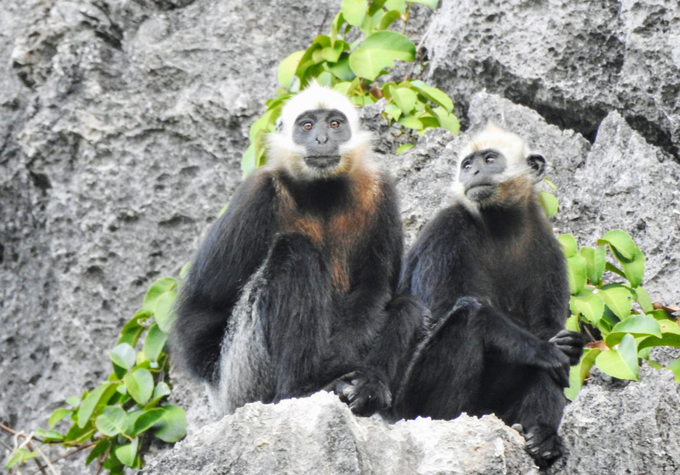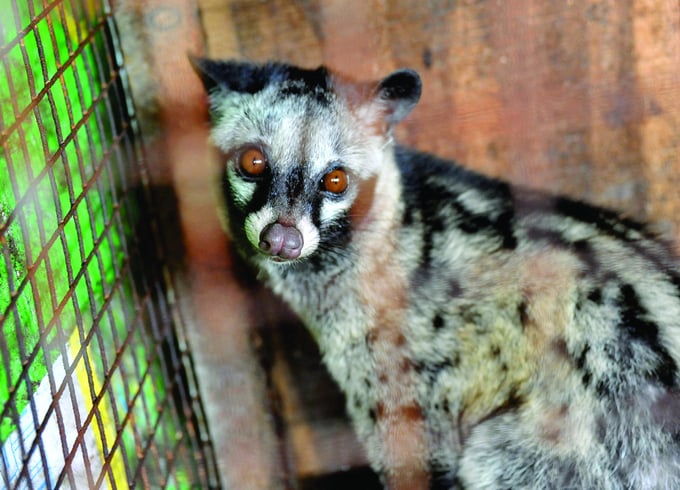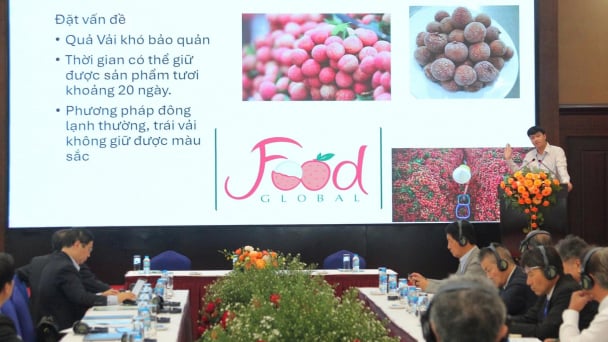June 18, 2025 | 04:46 GMT +7
June 18, 2025 | 04:46 GMT +7
Hotline: 0913.378.918
June 18, 2025 | 04:46 GMT +7
Hotline: 0913.378.918

According to OIE, 144 out of 335 new infections have emerged from wildlife in the last 60 years. Photo: VV.
Wildlife plays an essential role in preserving biodiversity and maintaining ecological balance. In certain locations, wildlife is also associated with culture, religion, tourism, etc.
Vietnam is one of the hotspots for wildlife consumption with a significant risk of disease transmission from wildlife to livestock and people as a result of its rising population, large livestock and poultry numbers, and diversified environments for wildlife.
Vietnam contains 322 species of wild animals, 397 types of reptiles, and over 900 species of wild birds, according to the administrative agency of the Convention on International Trade in Endangered Species in Vietnam (CITES Vietnam) under the Ministry of Agriculture and Rural Development.
In addition, there are several farms that raise animals such as macaques with long tails, porcupines, and civets among others. The bulk of wild meat eaten in Vietnam originates from wild animals or is purchased from wild animal farms, and there is a constant danger of infection transfer from wildlife to domestic animals or people.
Numerous dangerous infectious diseases, such as AIDS/HIV, Ebola, Middle East Respiratory Syndrome (MERS-Cov), the COVID-19 pandemic, and Monkey Smallpox, have originated from wild animals and are transferred to people via direct contact. One of the reasons of the epidemic is the intake and consumption of wild meat.
According to the World Organization for Animal Health (OIE), 144 out of 335 new infections have emerged from wildlife in the last 60 years, mostly from birds and nectars (ferrets, squirrels), bears, gorilla, and foxes.

Lack of technical disease control guidelines for commercial wildlife farms. Photo: VV.
According to the Department of Animal Health (MARD), Vietnamese law has regulated the control of diseases that can be transmitted from wildlife to humans, such as the Law on Prevention and Control of Infectious Diseases (2007), the Law on Veterinary Medicine (2015), and other legal documents, in which the state veterinary management agency plays a crucial role in the control of zoonoses to humans.
According to Mr. Phan Quang Minh, Head of the Epidemiology Department at the Department of Animal Health, organizations and individuals involved in wildlife breeding activities are responsible for preventing and treating animal diseases in accordance with Clause 2, Article 21 of the Law on Veterinary Medicine.
According to Article 7 of Circular No. 07/2016/TT-BNNPTNT dated May 31, 2016, incidents involving animals displaying symptoms of infectious diseases or dying for unusual or unknown reasons must be reported immediately to the local veterinary officer, communal People's Committee, or the nearest animal health authority.
If wild animals are suspected of being infected with zoonoses or novel diseases, animal health authorities at the district level or above must undertake an investigation and collect samples for pathogen testing. The handling of ill animals, the quarantine of contaminated regions, and the notification of disease outbreaks must comply with legislation.
Disease management for wild animals and their products should adhere to Circular No. 25/2016/TT-BNNPTNT dated 30 June 2016. Elephants, large cats, bears, deer, gibbons, orangutans, monkeys, pangolins, sloth monkeys, squirrels, stoats, iguanas, geckos, pythons, snakes, prairie chickens, pheasants, peacocks, other wild animals are susceptible to disease management. Meat, internal organs, remedies derived from wild animals (e.g., snake venom, bee venom, pangolin scales, bear bile, dried soup of animal bones), skins and leathers, hairs, stuffed tigers, leopards, civets, otters, and other wild creatures are subject to disease control. 22 common animal illnesses, 27 diseases on cud-chewing animals, 13 diseases on horses, 21 diseases on pigs, 22 diseases on birds, 20 diseases on monkeys, rabbits, stoats, and other animals fall within the purview of disease management.
According to Mr. Phan Quang Minh, despite the fact that there are several rules on the management of pathogens transferred from animals to people, there are still a large number of regulations that are incomplete or insufficient, resulting in practical challenges and barriers.
The principal substance of Circular 07 prescribes the prevention and control of terrestrial animal illnesses (including wild animals, according to the interpretation of phrases in the Law on Veterinary Medicine), primarily regulating the prevention and control of diseases in domestic animals (including animals such as livestock, poultry, pets). Although wild animals consist of several species, their natural habitat, environment, habitat, and behavior are distinct from those of domesticated animals.
Therefore, several restrictions applicable to animals, in general, may not be applicable to wildlife. According to Circular 07, the list of diseases transmitted from animals to humans includes eight diseases, most of which are transmitted from livestock. "However, competent state agencies should review and supplement the list of infectious diseases that are at risk of being transmitted from wildlife to humans, such as monkeypox, Nipah, etc.," proposed Mr. Phan Quang Minh.
In addition, state management authorities have not yet established technical standards for disease control at commercial and non-commercial wildlife farms, disease control at live wildlife marketplaces, and disease control at establishments where animal meat is eaten.
The director of the Department of Animal Health's Epidemiology Division also identified deficiencies in veterinary hygiene rules for facilities that raise, capture, and house wildlife. Specifically, the Ministry of Agriculture and Rural Development's Circular No. 09/2016/TT-BNNPTNT, released on June 1, 2016, does not control the killing of tamed wild animals (such as crocodiles, porcupines, porcupines, wild boar, etc.) or wildlife that may be hunted.
Each year, Vietnamese authorities make a large number of arrests for offenses linked to dealing, transporting, and consuming wildlife and wildlife products, but in the majority of these instances, pathogen testing is not conducted.
To reduce the risk of dangerous diseases transmitted from wildlife to humans, international organizations recommend that countries adopting the One Health (interdisciplinary collaboration) approach issue urgent regulations prohibiting the trade in live wildlife at traditional markets and regulating the breeding and trade of wildlife for human consumption.
it is also essential to develop rules, and mechanisms to control and monitor the exploitation, trading, and use of wildlife to assure safety, sustainability, and legality; launch communication campaigns on food safety for wildlife traders, consumers, and stakeholders.
Translated by Linh Linh

(VAN) The results of national programs are essential for establishing a contemporary livestock sector that is well-equipped to meet the demands of both domestic and international markets, with robust biosafety standards.

(VAN) The UNESCO Global Geopark revalidation of Non nuoc Cao Bang and the transition to a two-tier administrative model are presently undergoing a pivotal moment in Cao Bang, the northernmost province of Vietnam.
/2025/06/13/5330-2-004539_953.jpg)
(VAN) Changing policy mindset and removing investment barriers are urgent requirements to open up new development space for enterprises in the agricultural sector.

(VAN) The areas include the restoration of five million hectares of marine ecosystems.

(VAN) Dr. Le Van Nguyen, Director of the Institute of E-Commerce Management (ECM), emphasizes the potential for green development through the cultivation of fruit trees, particularly in provinces such as Son La.

(VAN) VAAS and numerous Vietnamese enterprises have signed cooperation agreements with Japanese partners to promote agricultural technology and trade connectivity.
/2025/05/29/5625-12-214801_567.jpg)
(VAN) Provincial mergers in the Mekong Delta promise to streamline administration, expand inter-provincial raw material areas, and foster close linkages in agricultural value chains, benefiting both businesses and cooperatives.